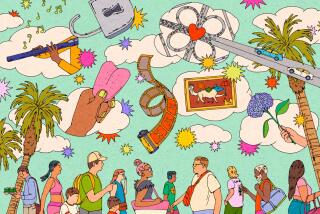The Pain That Is the Discovery of One’s Particular Life : WILD MEAT AND BULLY BURGERS by Lois-Ann Yamanaka; Farrar, Straus & Giroux; $20, 240 pages
The sharp teeth are rooted in soft gums. There is a bite to Lois-Ann Yamanaka’s story of a teenage girl struggling in Hawaii’s choppy ethnic and social currents. There is a moving portrait of the girl’s impulsive and frustrated father, and piquant details of the life and codes of a Hawaiian-Japanese community.
These are the virtues of “Wild Meat and Bully Burgers”; its defects are a frequently cliched account of adolescent hopes and pains, with blurs of sentimentality and melodrama.
Lovey Nariyoshi lives with her father, mother and little sister in a rundown section of Hilo, the county seat of Hawaii, biggest of the Hawaiian Islands. Her father was brought up in poverty on the sugar plantation where his father, an immigrant from Japan, cut cane for $8 a day. Lovey’s father--smart, ambitious and with some education--started too far behind. He supports his family in a variety of ways, but by comparison not only with the haoles--the whites--but with much of the ethnic Japanese community as well, they are poor.
Lovey fantasizes about being haole-blond, about tiled bathrooms with flowered paper-cup dispensers, about green lawns and nice furniture, instead of her family’s backyard chicken-run, and beat-up chairs and couches. Fantasy doesn’t hurt, though; what does hurt is to be snubbed at school by the wealthy Japanese American girls who belong to the “Rays of the Rising Sun” club. Lovey is chubby and ungraceful, besides; smart and yearning beyond her years; and her best friend and confidante is Jerry, who shares a crush on David Cassidy and a Barbie and Ken collection.
It is a small, intimate world; even outsiders have a place. And Lovey’s home, for all its scruffy improvisation, has warmth, loving relatives and good times. Lovey imagines a Martha Stewart Christmas with tree, candles, carols; but she makes do with her mother dancing while her Aunt Helen plays “Cockeyed Mayor of Kaunakakai” on the ukulele. There is pain that kills and pain that is simply the discovery of one’s particular and unique life. Mostly, that is the pain in “Bully Burgers.”
*
The brief chapters are a mosaic of Lovey’s recollections. There is her teacher drilling the children out of their pidgin patois. The narrator hints at disapproval but fudges it; Lovey and Yamanaka manage to have their pidgin while eating it. The author employs pidgin frequently and sometimes expressively but more as condiment than substance; the narration is mainly in standard English.
The cultural strains--between the Hawaiian Japanese and the haole, between the more and less Americanized Japanese--are indicated but not developed. Yamanaka is sketching a smaller canvas: a particular childhood, family and culture seen from the inside. There are Lovey’s crushes on a pregnant neighbor--she begs to be allowed to be the baby’s “aunt”--on a handsome high school hero who is friendly in private and aloof in public, on Crystal, the rich, kind and beautiful girlfriend of Jerry’s bullying older brother. There is the melodrama--which does not quite come off--when Crystal hangs herself after becoming pregnant.
The book’s dominant and best-written figure is Lovey’s father. He is a tinkerer, a dreamer, a passionately loving man who is torn between cherishing his daughter and arming her with rough lessons in life.
He is full of money-making schemes. He takes the family to gather macadamia nuts, he brings home a calf to fatten. The children christen it “Bully,” and the father explodes: “We going eat um, and how you going eat if you name him?”
At the table, months later, when the children suddenly realize they are being served Bully burgers, nobody can eat; not even their father.
Some of the best passages in the book are the stories he tells about his hard childhood as he and Lovey drive around the island buying up pheasant and peacock feathers to sell to a lei maker. They are moments of intimacy and paternal anguish: a tenderness expressed in harsh lectures on the need to be tough and hard-working to survive.
Through the harshness his dreams are visible; at the end, though, the tenderness falls into sentimental melodrama.
What is best in “Bully Burgers” is what is most particular in a family of constricted means and a frail, isolated and winning culture. What is weakest is what attempts to be universal, in terms of childhood loneliness, adolescent pain and the mysteries of growing up.


